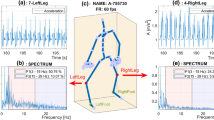Abstract
We present a method to calssify electromyogram (EMG) signals which are utilized as control signals for a patient-responsive walker-supported system for paraplegics. Patterns of EMG signals for different walking motions are classified via adequate filtering, real EMG signal extraction, AR-modeling, and a modified self-organizing feature map (MSOFM). In particular, a data-reducing extraction algorithm is employed for real EMG signals. Moreover, MSOFM classifies and determines the results automatically using a fixed map. Finally, the experimental results are presented for validation.
Similar content being viewed by others
References
Hefftner G, Zucchini W, Jaros GG (1988) The electromyogram (EMG) as a control signal for functional neuromuscular stimulation. Part I. Autoregressive modeling as a means of EMG signature discrimanation. IEEE Trans Biomed Eng 35:230–237
Hefftner G, Zucchini W, Jaros GG (1988) The electromyogram (EMG) as a control signal for functional neuromuscular stimulation. Part II. Practical demonstration of the EMG signature discrimination system. IEEE Trans Biomed Eng 35:238–242
Graupe D (1989) EMG pattern analysis for patient-responsive control of FES in paraplegics for walker-supported walking. IEEE Trans Biomed Eng 36:711–719
Pattichis CS, Schizas CN, Middleton LT (1995) Neural network models in EMG diagnosis. IEEE Trans Biomed Eng 42:486–496
Graupe D, Kordylewski H (1995) Artificial neural network control of FES in paraplegics for patient responsive ambulation. IEEE Trans Biomed Eng 42:699–707
Kobetic R, Triolo RJ, Marsolais EB (1997) Muscle selection and walking performance of multichannel FES systems for ambulation in paraplegia. IEEE Trans Rehab Eng 5:23–29
Laterza F, Olmo G (1997) Analysis of EMG signals by means of the matched wavelet transform. Electron Lett 33:357–359
Inbar GF, Noujaim AE (1984) On surface EMG spectral characterization and its application to diagnostic classification. IEEE Trans Biomed Eng BME-31:597–604
Park S-H, Lee S-P (1998) EMG pattern recognition based on artificial intelligence techniques. IEEE Trans Biomed Eng 6:400–405
Christodoulou CI, Pattichis CS (1999) Unsupervised pattern recognition for the classification of EMG signals. IEEE Trans Biomed Eng 46:169–178
Author information
Authors and Affiliations
Corresponding author
About this article
Cite this article
Choi, HL., Byun, HJ., Song, WG. et al. On pattern classification of EMG signals for walking motions. Artif Life Robotics 4, 193–197 (2000). https://doi.org/10.1007/BF02481174
Received:
Accepted:
Issue Date:
DOI: https://doi.org/10.1007/BF02481174




